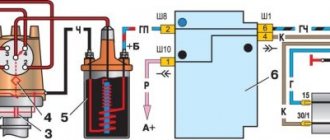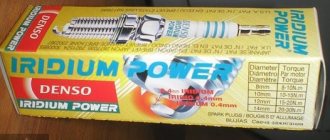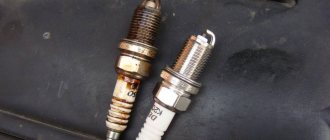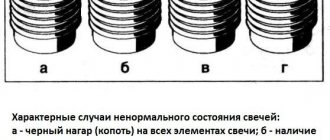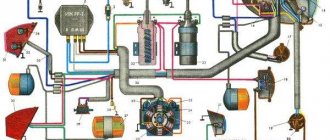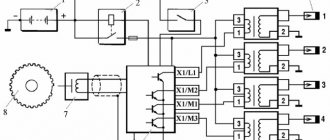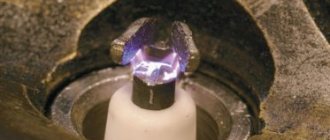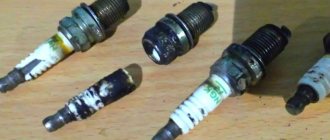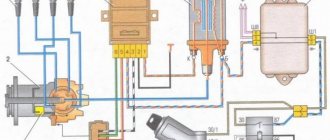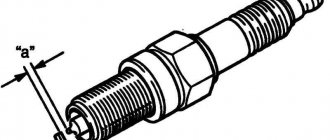Despite the simplicity of the structure of spark plugs, they need to be worked and handled correctly. They need to be cleaned correctly, selected and replaced correctly. However, even new options can sometimes cause problems - the car may run unevenly, sometimes there are jerks (shocks) when accelerating, as well as slight detonation. Many people immediately begin to look for the cause in the ignition system - of course, the spark plugs are new! However, the culprit may be a gap between the electrodes; just correct it and the engine will simply “sing”...
Spark plug gap
– this is the distance between the upper and lower electrodes, necessary for optimal operation and ignition of the fuel mixture. If this distance differs from the recommended standards, the engine will not run smoothly, and either twitching or detonation similar to “triple” of your unit is possible. In simple words, if the gap is different from the norm, set this way from the factory or by the seller, then you can shovel at least half of the motor, but you won’t find the reason. This is especially noticeable on carburetor systems. But first, I suggest starting with the device and operating principle.
If we talk about spark plugs, then this is like the last link in the ignition system, which is in direct contact with the air-fuel mixture. It is this element that sets it on fire, and does it either effectively and as laid down in the technical regulations, or ineffectively for a number of reasons (by the way, wear is often to blame).
After the fuel mixture (gasoline and air) has been supplied to the cylinders, the piston begins to go up and compress it, thereby increasing pressure. At the peak or, as is commonly called, the “top point,” the ECU gives an order and this composition ignites. Moreover, it is ignited by the spark plug - a spark runs between the electrodes, which is the catalyst. However, ignition may not occur, I am not currently considering options with a malfunction of the ignition system, the gap is simply set - the wrong one. Thus, “missing” may occur (that is, the fuel mixture does not ignite), which will cause your engine to operate with low efficiency, and sometimes it will not start at all (for example, in the morning in winter). But why does this happen?
• The influence of the correct clearance on the operation of the motor:
The gap is a really important parameter. It can either be big or too small.
If small values are set between the electrodes, then misfires will occur in the ignition system. The thing is that the spark that forms between the electrodes, which are as close to each other as possible, is not enough to ignite the fuel mixture. The spark, although strong, is not sufficient. This is why many cars will really jerk when driving and not develop enough speed. The carburetors may have flooded spark plugs, which will only cause problems – it will generally cause problems. The gap needs to be increased!
How much is a small gap? If we talk about size, it is approximately from 0.1 to 0.4 mm. We definitely check the candles after purchase, I’ll give practical recommendations below, but for now let’s talk about long distances.
You know, many manufacturers set the normal distance between the electrodes in advance. But over time, it can increase on its own. It's all about spark plug wear, which manifests itself with high mileage - this is natural. After all, the electrodes are made of metal, which, under the influence of temperature and constant electrical discharges, begins to slowly burn out. Both the upper one, which resembles the letter “G”, and the lower one suffer. The top one becomes thin, instead of a rectangular shape, it begins to be rounded, because the sides burn out.
The bottom one just sags down. Due to this distance, the spark that passes between the contacts weakens. And significantly! It may also not be enough to ignite the fuel. Often, because of this, the insulator of the lower contact is pierced; the whole point is that the spark tries to find the shortest path between the electrodes.
In winter, there is a high probability that the car simply will not start.
Large distance - from 1.3 mm and above. Normal gap, what you need to focus on.
We have very specific limits. Bottom from 0.4 mm (and everything below), top from 1.3 mm (and everything above). So what is considered the normal size for your car? You know, there are differences here too, they are connected primarily with the car’s ignition system, which can be roughly divided into three types:
1) For carburetor type, with distributor - normal clearance is from 0.5 to 0.6 mm
2) For carburetor type, with electronic ignition – 0.7 – 0.8 mm
3) Injector – 1 – 1.3 mm
Why such difference? The answer is simple - it's a matter of the ignition system and electrical circuit. The carburetor has the lowest voltage, so the spark will be weaker, and therefore the gap should be smaller. But the injector has the strongest energy system, so here the gap is increased, normal is considered to be 1 mm, and on many foreign cars it is 1.1 mm.
- How to check and how to set it.
The process is not as complicated as it seems at first glance. To begin with, we simply unscrew the spark plugs, then look for damage; if there is none, then you can first clean it, then check the gap. Of course, the gap can be measured with conventional measuring instruments, just a ruler. However, it is very difficult to determine 0.5 or 0.7 mm by sight! Therefore, now in stores you can buy so-called sets of “feelers” or special keys for checking the gap.
The probes look like metal curved letters “G”, with different sizes; we simply place them between the electrodes and determine the gap with an accuracy of 97%. If it is larger, for example on an injector than 1.1 mm, then the contacts are brought closer to each other, you can simply tap with the handle of a screwdriver. If it’s too close, then we move them apart from each other, again checking with a probe.
What I want to say in conclusion, many will think “come on,” why should I bother with some distance between the electrodes! Guys, very wrong thoughts.
Firstly, you can save on fuel, studies show up to 5 – 7%
Secondly, smooth engine operation is the key to driving safety.
Third, the correct gap between the spark plugs increases their service life; there is no chance that the insulator will break through (with an increased distance).
I would like to note that some companies, on the contrary, increase the number of contacts (electrodes), strengthen the coils and the ignition system, all so that the mixture is ignited better.
There are also more modern technologies now, which I think will soon replace them - such as plasma candles.
They have no electrodes at all, and the fuel is ignited by a beam of plasma that is generated by electricity. As they write, the production is now undergoing tests and they say that the combustion efficiency of the fuel mixture is increasing, and this means a little more power, a little more economy and environmental friendliness of the engine.
Thank you for reading the article to the end. Good luck on the roads.
Spark plug gap. What should it be and what does it affect?
Despite the simplicity of the structure of spark plugs, they need to be worked and handled correctly. They need to be cleaned correctly, selected and replaced correctly. However, even new options can sometimes cause problems - the car may run unevenly, sometimes there are jerks (shocks) when accelerating, as well as slight detonation. Many people immediately begin to look for the cause in the ignition system - of course, the spark plugs are new! However, the culprit may be a gap between the electrodes; just correct it and the engine will simply “sing”...
CONTENTS OF THE ARTICLE
First, a little definition.
The spark plug gap is the distance between the upper and lower electrodes, necessary for optimal operation and ignition of the fuel mixture. If this distance differs from the recommended standards, the engine will not run smoothly, and either twitching or detonation similar to “triple” of your unit is possible.
In simple words, if the gap is different from the norm, set this way from the factory or by the seller, then you can shovel at least half of the motor, but you won’t find the reason. This is especially noticeable on carburetor systems. BUT first, I suggest starting with the device and operating principle.
How to choose spark plugs
Trouble-free starting of a car engine and its stable operation are determined not only by the serviceability and flawless functioning of its systems, but also by the correct choice of spark plugs. A competent approach to purchasing these accessories will help prevent such problems:
- constant expenses for replacing spark plugs due to frequent breakdown of newly purchased ones;
- increased fuel consumption;
- breakdown of the socket for installing a candle.
Classification
The first sign by which different types of candles are distinguished is the number of electrodes:
- two-electrode designs are equipped with 2 electrodes: central and side;
- multi-electrode spark plugs have several (three or more) side electrodes (for example, three-electrode options).
The advantage of the multi-electrode design is that the engine runs stably due to the increased likelihood of spark formation. If one of the elements does not work, the other “helps out”.
Manufacturing materials
The following types of materials are used to make burning candles:
- a combination of alloy steel with metals such as nickel, chromium and manganese;
- sputtering a layer of platinum;
- coating with iridium film is the most expensive option.
The first type of product is considered classic. Numerous tests have shown a good working life of nickel electrodes. The copper core successfully removes heat, which avoids thermal overload. The standard option is the most budget-friendly due to the use of relatively cheap materials.
Platinum spark plugs have recently appeared on the market, so they can rightfully be considered an innovation in the automotive industry. New models are distinguished by a longer period of use due to the use of noble metal. In addition, the use of platinum contributes to the stable power generated by the engine under different operating conditions. The thickness of the electrode is less than that of classic models.
The goal of developing iridium spark plugs is to reduce ignition voltage and optimize flame distribution. Iridium is a hard, chemically resistant metal that is not subject to corrosion. Thanks to this, it was possible to create a thin but unusually durable electrode. These are products from the “set it and forget it” category. The working life of these products, as tests show, is very long, but the cost, when compared with classics, is several times higher.
additional characteristics
Before you buy spark plugs, you need to carefully study the table of technical characteristics, since these parameters play an important role when choosing:
- heat number is an indicator of the temperature regime of the product. With a high heat value, the spark plug itself heats up less. If it is low, then the product becomes very hot, which can lead to burnout of the gaskets and pistons. The specific choice depends on the parameter specified in the car’s operating manual. Products with a low heat rating cannot be used;
- spark gap. This is the name of the interval between the central and side electrodes. Sometimes you have to change this parameter to suit your own car, but experts do not advise doing this unless absolutely necessary. The efficiency of the spark plug may be reduced;
- thread parameters: diameter and length.
Labor resources are also important. If the product is selected correctly, it will work for the period between vehicle services without any problems. However, this rule works if there are no problems with the health of the engine or fuel system.
How does ignition work in a cylinder?
If we talk about spark plugs, then this is like the last link in the ignition system, which is in direct contact with the air-fuel mixture. It is this element that sets it on fire, and does it either effectively and as laid down in the technical regulations, or ineffectively for a number of reasons (by the way, wear is often to blame).
After the fuel mixture (gasoline and air) has been supplied to the cylinders, the piston begins to go up and compress it, thereby increasing pressure.
At the peak or, as is commonly called, the “top point,” the ECU gives an order and this composition ignites. Moreover, it is ignited by the spark plug - a spark runs between the electrodes, which is the catalyst.
However, ignition may not occur, I am not currently considering options with a faulty ignition system, it’s just that the gap is set incorrectly. Thus, “missing” may occur (that is, the fuel mixture does not ignite), which will cause your engine to operate with low efficiency, and sometimes it will not start at all (for example, in the morning in winter). But why does this happen?
This is interesting: Spark plug tester
Design and features of the use of spark plugs for VAZ cars
Spark plug device for VAZ 2114
In terms of design, the spark plugs for the VAZ 2114 are no different from the SZ used in the ignition systems of other cars. The main elements of this device are:
- the body is made of metal, on the outside there is a hex head for a spark plug wrench and a threaded part for screwing into the cylinder head housing, this part absorbs 67 percent of the heat generated when the spark plug fires and transfers 91 percent of this heat to the cylinder head housing;
- an insulator made of corundum ceramics with the addition of aluminum oxide, as well as oxides of other rare metals. It is inserted into a metal case;
- thermal cone, often called the thermal cone skirt. In fact, this is the lower part of the insulator; it absorbs 21 percent of the heat released at the moment of sparking;
- a plug head is attached in the upper part of the insulator, inside it there is a contact rod mated to the head, and in the lower part there is a central electrode;
- on the lower part of the spark plug body there is a side electrode, which is located above the protruding part of the central electrode, forming a gap for the formation of a spark;
- the thrust part of the body is flat; for better tightness during installation, a sealing washer is placed on it;
- to create strength and tightness of connections inside the structure, there are ring seals and a heat-conducting glass sealant;
- To combat radio interference that occurs during sparking, a noise suppression resistor can be installed between the contact head and the central electrode.
All components of the spark plug on the VAZ 2114 play an important role, but special attention is paid to the central electrode. It must have such properties as heat resistance, high thermal conductivity, ductility and have high corrosion and erosion resistance
For this purpose, it is usually made from various nickel alloys. However, in recent years, in order to improve the efficiency of the spark plug and obtain any unique properties during its operation, this electrode began to be produced from metals such as copper, iridium, palladium, as well as with platinum deposition and silver or gold coating.
Despite the simplicity of the candle
ignition, they must be handled and handled correctly. They need...
Injector spark plug gaps
Checking and adjusting the spark plug gap
for injection
VAZ
2115.
This is interesting: Where is the fuel pump fuse on the VAZ-2110 - photo, video
The influence of the correct clearance on engine performance
The gap is a really important parameter. It can either be big or too small.
Small gap
If small values are set between the electrodes, then misfires will occur in the ignition system. The thing is that the spark that forms between the electrodes, which are as close to each other as possible, is not enough to ignite the fuel mixture. The spark, although strong, is not sufficient. This is why many cars will really jerk when driving and not develop enough speed. The carburetors may have flooded spark plugs, which will only cause problems – it will generally cause problems. The gap needs to be increased!
How much is a small gap? If we talk about size, it is approximately from 0.1 to 0.4 mm. We definitely check the candles after purchase, I’ll give practical recommendations below, but for now let’s talk about long distances.
Big gap
You know, many manufacturers set the normal distance between the electrodes in advance. But over time, it can increase on its own.
It's all about spark plug wear, which manifests itself with high mileage - this is natural. After all, the electrodes are made of metal, which, under the influence of temperature and constant electrical discharges, begins to slowly burn out. Both the upper one, which resembles the letter “G”, and the lower one suffer. The top one becomes thin, instead of a rectangular shape, it begins to be rounded, because the sides burn out. The bottom one just sags down.
Due to this distance, the spark that passes between the contacts weakens. And significantly! It may also not be enough to ignite the fuel.
Often, because of this, the insulator of the lower contact is pierced; the whole point is that the spark tries to find the shortest path between the electrodes.
In winter, there is a high probability that the car simply will not start.
Large distance - from 1.3 mm and above.
Choice
The choice of candles today is quite extensive. But we’ll talk about which ones are used for the VAZ 2110 and what can currently be considered the best choice for your car.
Candles differ from each other mainly in the material from which the electrodes are made.
Candle type
Peculiarities
These are classic spark plugs for VAZ, installed by the factory. The operating life is up to 50 thousand kilometers. Some of them are coated with yttrium alloy to increase the reliability of the electrode.
They are characterized by increased resistance to temperature fluctuations and corrosion, which has a positive effect on the service life of the elements. Such elements are capable of operating up to 90 thousand kilometers
The characteristics are in many ways close to platinum candles; today they are considered the most durable and high-quality. Safety margin - about 90-100 thousand kilometers
The service life may increase or decrease depending on the care, conditions of use of the vehicle, and the quality of the fuel being poured.
Platinum candle
Replacement
If cleaning and drying did not give any result, and checking the remaining elements of the ignition circuit did not reveal other sources of problems, then the fault lies with the spark plugs. They need to be replaced.
Replacing an elementTo replace spark plugs you will need:
- Spark plug head;
- Ratchet or crank;
- Extension;
- A set of new spark plugs.
Let's get to work.
- Disconnect the high-voltage wires from the spark plugs on your VAZ 2110.
- The ignition elements are unscrewed using the head and knob.
- The first movement when unscrewing can be difficult, therefore it is strongly not recommended to unscrew the spark plugs sharply. You may strip the threads.
- If during dismantling the spark plug gets stuck, screw it back a couple of turns, then carefully unscrew it again.
- Clean the places where the spark plugs are planted from any dirt that has formed, check the condition of the rings.
- Install new spark plugs in place of the old ones. It is necessary to tighten the elements with a certain torque - 31-19 Nm.
- Connect the high-voltage wires and test run the engine.
We remove it with a puller
Even if these are new spark plugs, we advise you to first check the gap level so that it complies with the regulated standards.
Replacing spark plugs is quite simple, as is checking the gap. But when choosing between cleaning and replacement, we recommend choosing the second option. The fact is that using any of the above methods for cleaning spark plugs can harm the car. This is especially true for chemically aggressive substances; contact with engine components or engine compartments can lead to quite dire consequences. It's much easier to just change the spark plugs. Moreover, they are not expensive.
Owning a car means regularly replacing many parts. One of these parts are spark plugs, which are responsible for the timely ignition of the air-gasoline mixture. Their performance is assessed by analyzing the gap between the electrodes. It can vary depending on many factors. Therefore, if problems arise in the operation of the engine, the spark plugs are first checked. In this case, the gap between the electrodes is assessed. Then you can ask the question - what should be the gap on the spark plugs so that there are no problems in a running car.
Normal gap, what you need to focus on
We have very specific limits. Bottom from 0.4 mm (and everything below), top from 1.3 mm (and everything above). So what is considered the normal size for your car?
You know, there are differences here too, they are connected primarily with the car’s ignition system, which can be roughly divided into three types:
1) For carburetor type, with distributor - normal clearance is from 0.5 to 0.6 mm
2) For carburetor type, with electronic ignition – 0.7 – 0.8 mm
3) Injector – 1 – 1.3 mm
Why such difference? - you ask. The answer is simple - it's a matter of the ignition system and electrical circuit. The carburetor has the lowest voltage, so the spark will be weaker, and therefore the gap should be smaller. But the injector has the strongest energy system, so here the gap is increased, normal is considered to be 1 mm, and on many foreign cars it is 1.1 mm.
The value of optimal clearances
Acceptable operating parameters at which the system remains fully operational are gaps in the range of 0.6–1.2 mm. Clear values are selected depending on the type of power plant, various power supply and ignition systems. You should focus on the following characteristics:
- old carburetor engines, which have motors with a low compression ratio and mechanical sparking functionality, will work optimally at 0.6–0.7 mm;
- similar power plants with modernized contactless ignition using electronics will be effective at 0.8–0.9 mm;
- for naturally aspirated engines reinforced with turbines and equipped with an injection type injection, it is preferable to provide a gap of 1–1.2 mm.
How to check and how to set it
The process is not as complicated as it seems at first glance. To begin with, we simply unscrew the spark plugs, then look for damage; if there is none, then you can first clean it, then check the gap.
Of course, the gap can be measured with conventional measuring instruments, just a ruler. However, it is very difficult to determine 0.5 or 0.7 mm by sight! Therefore, now in stores you can buy so-called sets of “feelers” or special keys for checking the gap.
The probes are similar to metal curved letters “G”, with different sizes; we simply place them between the electrodes and determine the gap with an accuracy of 97%. If it is larger, for example on an injector than 1.1 mm, then the contacts are brought closer to each other, you can simply tap with the handle of a screwdriver. If it’s too close, then we move them apart from each other, again checking with a probe.
Watch my video about the gap.
Clearance and Resistance
Each manufacturer selects candles from certain manufacturers for itself. Here there is not only the required gap, but also resistance.
A gap of about 0.8 - 1 mm is considered normal; the resistance of the spark plug is usually not indicated on the body, but in sellers' catalogs you can select it specifically for your engine.
It is worth noting that if you take an element of incorrect clearance and resistance, then on the contrary, you can worsen the performance of your car ! After all, the spark plug is matched to the ignition coil of your exact make and model. THIS NEEDS TO BE UNDERSTANDED.
Modern technologies
What I want to say in conclusion, many will think “come on,” why should I bother with some distance between the electrodes! Guys, very wrong thoughts.
Firstly , you can save on fuel, studies show up to 5 - 7%
Secondly , smooth engine operation is the key to driving safety.
Third , the correct gap between the spark plugs increases their service life; there is no chance that the insulator will break through (with an increased distance).
I would like to note that some companies, on the contrary, increase the number of contacts (electrodes), strengthen the coils and the ignition system, all so that the mixture is ignited better.
There are also more modern technologies now, which I think will soon replace them - such as plasma candles.
They have no electrodes at all, and the fuel is ignited by a beam of plasma that is generated by electricity. As they write, the production is now undergoing tests and they say that the combustion efficiency of the fuel mixture is increasing, which means a little more power, a little more economy and environmental friendliness of the engine.
And that’s all for me, read our AUTOBLOG, it will be interesting.
ADVANTAGES AND DISADVANTAGES
I made a small sign and wrote down all the positive and negative points on it.
| PROS | MINUSES |
| Strong spark, stable start (even in winter) | High price, 3-4 times more expensive than conventional analogues |
| Long service life (more than 100,000 km) | No promised power increase |
| Smooth and soft engine operation | There is no great fuel economy (and within an error of about 2-3% you will not feel it) |
I would like to say a few words about cleaning such elements, there is a huge amount of information on the Internet that says you can’t clean them AT ALL! And even if you put in bad gasoline and the spark plug becomes covered with a coating (say, red from additives) or carbon deposits, then you need to install new ones. But friends, this is essentially nonsense. They are easy to clean, but you don’t need to do it with sandpaper (this will remove the working layer), just soak them in cleaning liquids (ordinary kitchen detergents will do) and then clean everything with a soft brush (an old toothbrush is ideal). And they are working again.
The gap between the spark plug electrodes and its adjustment
The proper operation of an internal combustion engine depends on many factors. One of the most important among them is the condition of the spark plugs, namely the gap between their electrodes. When the engine starts to run erratically or misfire, suspicion first falls on them. Most car owners go and simply buy a new kit, being sure that the problem can only be solved by replacement. Meanwhile, in most cases, it is enough to set the correct gap on the spark plugs, and the engine will begin to operate stably again.
Iridium or platinum?
The question often arises: “Should I buy platinum or iridium spark plugs?” In order to give an answer, we need to take a closer look at them.
Platinum devices are very durable. This material has high anti-corrosion properties and is resistant to temperature changes. This tip prevents the electrode from burning. Of course, the service life of such candles is longer than that of classic ones. Platinum spark plugs are ideal for engines that have a mechanical or turbocharger.
What causes an incorrect spark plug gap?
The distance between the electrodes can deviate from the norm both up and down. Depending on which gap, increased or decreased, the consequences will be different.
Increased clearance
This deviation is dangerous, first of all, because it can cause breakdown of the spark plug insulator or ignition coil. This happens because electricity strives to find the shortest path for itself.
If breakdown does not occur, there is a high probability of spark loss. In this case, the cylinder simply will not work and the engine will start to stall. A characteristic sign of an increased gap between the electrodes is popping noises in the exhaust system. At high speeds, misfires become especially noticeable.
Reduced clearance
If the interelectrode gap is less than normal, the spark discharge that ignites the combustible mixture is very powerful and short. The latter leads to the fact that the fuel in the cylinders does not have time to ignite, and the spark plugs will begin to flood, and the engine will begin to stall.
At high speeds there is a high probability of arcing. Due to the fact that the distance between the electrodes is too small and the crankshaft speed is high, the spark does not have time to break, and a continuous stream of plasma is formed. As a result, the ignition coil may short out or, at a minimum, malfunctions in the operation of the power unit may occur.
What is iridium?
Iridium is a very hard metallic element. It is believed that this material was formed on our planet due to meteor showers many years ago. It is precisely because this metal has high hardness that it is used as an electrode material for the manufacture of spark plugs. Its second important property is melting at a temperature of about 2,800°C.
Very reliable, have a long service life and are resistant to temperature changes - all these are iridium spark plugs. Reviews from owners of cars “filled” with this metal confirm this fact on thematic forums.
Since the 80s of the last century, this material began to be actively used as an alloy for igniters in industrial production. Due to its fragility and low electrical conductivity, this metal cannot be used in its pure form. Only in alloys does iridium show its best properties.
How to measure the gap between electrodes
The spark gap is measured with a special cylindrical or flat probe. The measurement is carried out as follows: the candle is held with the working part up, and between the central and each of the side electrodes (if there are several of them) measures are inserted from smallest to largest. You don't need to put in a lot of effort. The measure should pass closely with slight pressure; its diameter is the size of the spark gap. Alternatively, you can use a coin-shaped feeler gauge.
You can do it differently: knowing what the gap should be in accordance with the requirements of the car manufacturer, select the appropriate measure and insert it between the electrodes.
- If it does not go in, then the gap is too small and needs to be increased;
- if, on the contrary, it passes freely, the distance must be reduced.
Too much clearance
Before setting the gap on the spark plugs, you need to know that if its value is more than 1.3 mm, such an interval will be considered increased. If the distance between the electrodes turns out to be this way, this will lead to the following consequences:
- the calculated coil power will be less than what is required in reality, so sparking will not occur in every cycle, and there will be gaps in operation;
- the engine will begin to operate intermittently and unstably, which will contribute to the occurrence of unwanted vibrations;
- non-burnable fuel will partially penetrate into the crankcase, flowing down the cylinder walls, and will also be partially sent to the exhaust system;
- the power of the internal combustion engine will noticeably decrease, and gasoline consumption will increase significantly;
- a noticeable undesirable layer of carbon will form on the cylinder, the working part of the spark plug, and carbon will also appear on the piston.
The penetration of fuel into the crankcase oil provokes dilution of the lubricant and the formation of flammable vapors, which freely penetrate into the combustion chamber. This is facilitated by all kinds of pipes and the presence of an air path.
In addition to the drop in power parameters, the negative will be an increase in wear of the mating elements. Their effective operating period is significantly reduced. The car starts less confidently, this is especially noticeable when starting “cold”. A cold engine often requires several attempts to start.
Gap adjustment
The candles themselves must be carefully cleaned with a rag and make sure that they do not have mechanical damage in the form of cracks, chips or swelling on the porcelain insulator.
During manipulations, care should be taken not to damage anything. The adjustment itself is made by bending or bending the side electrode. You can bend it by lightly tapping it with something hard, for example, with pliers. You can bend the side electrode either with pliers or a flat-head screwdriver.
Do I need to adjust the gap on new spark plugs?
The answer, meanwhile, is simple: manufacturers, for example, the same company NGK, make spark plugs for specific engines; just find your car in the compatibility table on the packaging.
The precision of manufacturing now means you don’t have to worry about whether the gap is set correctly. Unfortunately, this cannot be said about domestic products: when purchasing four A17DVRM spark plugs, you can find that they all have different gaps. You should also pay attention to the appearance of the spark plugs: they should not have visible flaws, and the side electrode should be located exactly above the central one.
Based on the above, we can conclude that before screwing in new spark plugs, if they are made in Russia, it is advisable to make sure that the distance between the electrodes meets the requirements of the car manufacturer. In the case of foreign products, such as Bosch or NGK, an external inspection is sufficient.
Replacing spark plugs on a VAZ-2112 16 valves: video and photos
There is no doubt that the procedure for replacing spark plugs on a VAZ-2112 is very important and necessary. As a rule, it should be carried out every 25-30 thousand kilometers or without waiting for this period, if malfunctions occur.
When to change spark plugs?
Such malfunctions include: engine tripping, increased fuel consumption, difficult starting, etc. The condition of the spark plugs can be determined by visually inspecting the central part of the spark plug or its body. The presence of soot, dirt, and various cracks will directly indicate the need to replace it.
To make it easier for you to determine the condition of your candles by visible signs, we bring to your attention a special table.
Using this table it is very easy to determine the condition of the candles
Replacing spark plugs yourself
Before you start replacing old spark plugs, decide on the choice of new ones, you can read about this in this article. Also, before starting dismantling, make sure to place the car on a flat surface and disconnect the negative cable from the battery.
Required Tools
To ensure that the work of replacing spark plugs does not cause inconvenience, prepare all the necessary tools in advance:
Please note that the spark plug wrench must have a rubber seal, or it must be magnetized, to most effectively hold the spark plug while removing it from the well
Step by step order
- First, remove the plastic engine casing located on top.
If the bolts are not corroded, they will come out easily.
- Then disconnect the terminals from the individual ignition coils one by one.
- Using a “10” key, unscrew the bolt that secures it to the cylinder head cover.
When the bolts are unscrewed, move them to the side.
Using a screwdriver, remove it from its seat and move it to the side. Inspect the spark plug wells for damage, and be sure to check for oil in them. And if oil is found in at least one of them, you should immediately find out the cause of its origin, since in most cases the culprit is a failed cylinder head gasket, and in this case you simply cannot do without removing the cylinder head. Next, in order to dismantle the spark plug, we will need a special spark plug wrench, or a spark plug head and extension.
Gaps on iridium spark plugs
Many manufacturers produce spark plugs with a thin central electrode made of precious metals: platinum, silver or iridium. According to them, such spark plugs are more durable and provide better quality of spark formation compared to conventional ones.
Indeed, on NGK iridium spark plugs the spark is more stable and less dependent on the gap between the electrodes. Another feature of iridium spark plugs is that they provide a small increase in engine power (about 5%). Finally, the spark discharge goes around the central electrode in a circle, promoting self-cleaning of the spark plug.
This is interesting: Selection of Sachs shock absorbers by car brand
Review (rating) of recommended candles for HBO
Based on numerous reviews from drivers, we will consider some of the most popular models of spark plugs for working on a propane-butane mixture and methane with brief characteristics.
The most common (due to cheapness) Brisk Silver spark plugs for gas (Brisk Silver LPG/CNG - Czech Republic) have a silver central electrode of small diameter. Their price varies from 120-300 rubles per piece:
| Candle marking | Gap, mm | Seal | Replacement interval, km | Key size, mm | Thread length, mm | Thread size | Tightening torque, N*m |
| 1BR12S | 0.55 | w | max. 20.000 | 16 | 15 | M 12×1.25 | 15-20 |
| AR12YS | 0.7 | w | max. 30.000 | 16 | 19 | M 10×1.00 | 10-15 |
| AR14YS | 0.7 | w | max. 30.000 | 16 | 19 | M 10×1.00 | 10-15 |
| BR14YS | 0.7 | w | max. 30.000 | 16 | 19 | M 12×1.25 | 15-20 |
| BR14YS-9 | 0.9 | w | max. 30.000 | 16 | 19 | M 12×1.25 | 15-20 |
| DOR15YS | 0.7 | w | max. 30.000 | 16 | 21 | M 14×1.25 | 20-30 |
| DOR15YS-1 | 1 | w | max. 30.000 | 16 | 21 | M 14×1.25 | 20-30 |
| DR14YS | 0.7 | w | max. 30.000 | 16 | 19 | M 14×1.25 | 20-30 |
| DR14YS-9 | 0.9 | w | max. 30.000 | 16 | 19 | M 14×1.25 | 20-30 |
| DR15YS | 0.7 | w | max. 30.000 | 16 | 19 | M 14×1.25 | 20-30 |
| DR15YS-9 | 0.9 | w | max. 30.000 | 16 | 19 | M 14×1.25 | 20-30 |
| DR17YS | 0.7 | w | max. 30.000 | 16 | 19 | M 14×1.25 | 20-30 |
| DR17YS-9 | 0.9 | w | max. 30.000 | 16 | 19 | M 14×1.25 | 20-30 |
| ER15YS-9 | 0.9 | w | max. 30.000 | 16 | 26,5 | M 14×1.25 | 20-30 |
| GR14YS | 0.7 | K | max. 30.000 | 16 | 17,5 | M 14×1.25 | 10-20 |
| GR15YS | 0.7 | K | max. 30.000 | 16 | 17,5 | M 14×1.25 | 10-20 |
| GR15YS-9 | 0.9 | K | max. 30.000 | 16 | 17,5 | M 14×1.25 | 10-20 |
| GR17YS | 0.8 | K | max. 30.000 | 16 | 17,5 | M 14×1.25 | 10-20 |
| LR12YS | 0.7 | w | max. 30.000 | 21 | 19 | M 14×1.25 | 20-30 |
| LR14YS | 0.7 | w | max. 30.000 | 21 | 19 | M 14×1.25 | 20-30 |
| LR15YS | 0.7 | w | max. 30.000 | 21 | 19 | M 14×1.25 | 20-30 |
| LR15YS-9 | 0.9 | w | max. 30.000 | 21 | 19 | M 14×1.25 | 20-30 |
| LR17YS | 0.7 | w | max. 30.000 | 21 | 19 | M 14×1.25 | 20-30 |
| LR17YS-9 | 0.9 | w | max. 30.000 | 21 | 19 | M 14×1.25 | 20-30 |
| LOR15YS | 0.7 | w | max. 30.000 | 21 | 21 | M 14×1.25 | 20-30 |
| MR14LS | 0.7 | w | max. 30.000 | 14 | 26,5 | M 12×1.25 | 15-20 |
| NR14S | 0.55 | w | max. 30.000 | 21 | 12,7 | M 14×1.25 | 20-30 |
| NR15S | 0.55 | w | max. 30.000 | 21 | 12,7 | M 14×1.25 | 20-30 |
| RR15YS | 0.7 | K | max. 30.000 | 16 | 25 | M 14×1.25 | 10-20 |
| RR15YS-9 | 0.9 | K | max. 30.000 | 16 | 25 | M 14×1.25 | 10-20 |
| RR15YS-1 | 1 | K | max. 30.000 | 16 | 25 | M 14×1.25 | 10-20 |
| RR17YS-1 | 1 | K | max. 30.000 | 16 | 25 | M 14×1.25 | 10-20 |
| K-cone seal |
| Ш-sealing with washer |
Affordable candles from Bosch (Bosch-Germany) also have excellent recommendations and are marked BGB in the catalog. Well suited to internal combustion engines with 4th generation LPG. Cost 180-220 rubles. for one unit:
| Spark plug marking/electrode material | Gap, mm | Seal | Replacement interval, km | Key size, mm | Thread length, mm | Thread size | Tightening torque, N*m |
| FR7DC/chrome-nickel with copper rod | 0,9 | w | max. 30.000 | 16 | 19 | M 14×1.25 | 30 |
| YR6DES/silver | 0,7 | w | max. 40.000 | 16 | 19 | M 12×1.25 | 25 |
| WR7DP/platinum | 0,8 | w | max. 60.000 | 21 | 19 | M 14×1.25 | 30 |
Denso candles of the TT series (Denso-Japan) can be considered the best in terms of price/quality ratio. The central and side electrodes are made of nickel alloy, which ensures smooth engine operation, fuel economy and reduced exhaust emissions. Price for one piece is 150-180 rubles. The line also includes iridium spark plugs for gas equipment, which are not so affordable in price (550 rubles per 1 piece), but have an increased service life, more stable spark formation and resistance to low temperatures:
| Spark plug marking/electrode material | Gap, mm | Seal | Replacement interval, km | Key size, mm | Thread length, mm | Thread size | Tightening torque, N*m |
| W22TT/nickel | 0,8 | w | max. 60.000 | 16 | 17,5 | M 14×1.25 | 20-25 |
| K20TT/nickel | 1,1 | w | max. 60.000 | 16 | 19 | M 14×1.25 | 20-25 |
| IT20TT/iridium | 0,8 | w | max. 120.000 | 16 | 17,5 | M 14×1.25 | 20-25 |
| IW20TT/iridium | 0,8 | w | max. 120.000 | 21 | 19 | M 14×1.25 | 20-25 |
| IK20TT/iridium | 1,1 | w | max. 120.000 | 16 | 19 | M 14×1.25 | 20-25 |
| VW22/iridium | 0,8 | w | max. 120.000 | 21 | 19 | M 14×1.25 | 20-25 |
An excellent choice for most cars - NGK LPG LaserLine No. 1-8 spark plugs with a central iridium electrode, platinum soldering on the side electrode and a special insulator design ensure optimal operation of the internal combustion engine in any operating mode. There is one drawback - the price for 1 piece is on average 700 rubles:
| Candle marking | Gap, mm | Seal | Replacement interval, km | Key size, mm | Thread length, mm | Thread size | Tightening torque, N*m |
| LPG 1 | 0,8 | Sh | max. 60.000 | 16 | 19 | M 14×1.25 | 25-30 |
| LPG 2 | 0,8 | Sh | max. 60.000 | 21 | 19 | M 14×1.25 | 25-30 |
| LPG 3 | 0,8 | Sh | max. 60.000 | 16 | 19 | M 14×1.25 | 25-30 |
| LPG 4 | 0,8 | To | max. 60.000 | 16 | 25,5 | M 14×1.25 | 10-20 |
| LPG 5 | 0,8 | w | max. 60.000 | 16 | 17,5 | M 14×1.25 | 25-30 |
| LPG 6 | 0,8 | w | max. 60.000 | 16 | 19 | M 14×1.25 | 25-30 |
| LPG 7 | 0,8 | w | max. 60.000 | 16 | 26,5 | M 14×1.25 | 25-30 |
| LPG 8 | 0,8 | w | max. 60.000 | 16 | 19 | M 12×1.25 | 15-20 |
A more detailed selection of spark plugs for a specific car can be made by downloading the electronic catalog of the manufacturer of interest using the links below.
- We select spark plugs denso, ngk, bosh, beru, champion by car make
Source
Blog about UAZ
To clean and adjust the gaps between the electrodes, the spark plugs must be removed from the engine cylinder head. Before removing the spark plugs, it is advisable to clean the sockets in the cylinder head and blow them out with compressed air.
Checking the spark plugs, adjusting the gaps between the electrodes, restoring the functionality of the spark plugs, removing a broken spark plug, restoring the threads.
When inspecting any spark plug, first of all pay attention to carbon deposits. Carbon deposits are a good conductor, so they cause current leakage in the spark plug. The leakage current of a new spark plug is very small and has virtually no effect on the operation of the ignition system. During operation, the thickness of the deposit increases, its resistance decreases, and the leakage current increases.
As the leakage current increases, the voltage between the electrodes of the spark plug decreases and finally, a moment comes when the spark plug stops working. The formation of carbon deposits on the spark plug insulator is normal and inevitable. However, if you find carbon deposits, do not rush to clean it. First, pay attention to its thickness and color.
You can remove carbon deposits from a candle with a metal brush, but it is better to make a simple device, shown in the figure below. By filling the tube with dry river sand or a special grinding powder, you can shake the tube vigorously and manually clean the candle in a few minutes.
Naturally, after cleaning, the spark plug needs to be washed with gasoline and dried. It should be remembered that when cleaning spark plugs, small scratches are formed on their insulators, which accelerate the process of carbon formation. Therefore, it is advisable to use cleaned candles only in summer. Before the onset of cold weather, it is better to replace the spark plugs with new ones.
Adjusting the gap between the central and side electrodes of the spark plugs.
After cleaning the spark plugs from carbon, check and adjust the gap between the central and side electrodes. This operation must be carried out before winter operation of the car. For example, the gap between the spark plug electrodes should be in the range of 0.85+-1.0 mm for A11U spark plugs and 0.6+-0.75 mm for CH302-B spark plugs.
During operation, this gap constantly increases due to natural wear and tear of the contact material. Increasing the spark plug gap leads to an increase in breakdown voltage, which causes a disruption in spark formation and increased fuel consumption. For 100 kilometers, with an increase in the gap by 0.1 mm, fuel consumption increases by approximately 0.5 liters.
You need to check the gaps between the spark plug electrodes using a round feeler gauge. A flat feeler gauge does not take into account the uneven wear of the electrodes and can give a large error in measuring the gap. The gap between the electrodes can be increased or decreased only by bending the side electrode.
After adjusting the gap, put the spark plug in place, first screwing it in by hand and then tightening it using a socket wrench. If you are servicing a completely new car, it is advisable to apply a layer of graphite powder to the threaded part of the spark plugs before installation. This will make it easier to unscrew the spark plug for maintenance and replacement in the future.
Checking the serviceability and functionality of the spark plugs.
You can check the functionality and condition of the spark plug (without turning it out of the socket) with a special probe or indicator. The spark plug tester is made in the form of a pistol and has a piezoelectric generator that produces voltage pulses with an amplitude of 4.0-4.2 kV. After connecting the device to the spark plug and pressing the trigger, observe the control light of the device.
If the light flashes, then the spark plug is working. If the light does not light up, this means that either the electrodes of the spark plug are covered with a thick layer of carbon deposits, or the gap between them is increased, or the spark plug itself is faulty.
The spark plug service indicator is installed in the gap between the spark plug and the high-voltage wire going to it. The serviceability of the spark plug is determined by the readings of the instrument's pointer indicator when the engine is running at average crankshaft speed.
If there is no probe or indicator, then the serviceability of the spark plugs can be checked by turning them off one by one while the engine is running. If, when removing the wire from the spark plug, the crankshaft rotation speed changes, then the spark plug is in good condition. Since electric shocks are possible when removing the wires from the spark plugs, it is better to use a simple device, as shown in the figure below.
The device is a regular awl to which a wire with an alligator clip is connected. Connect the clamp to the ground of the car, and to disconnect the spark plug, insert the tip of an awl between the high-voltage wire and the rubber cap on the distributor cover.
Checking the reliability of the spark plug insulator.
Check the integrity of the spark plug insulator. Remove the spark plug, close the gap between the electrodes with some dielectric, and then, putting a tip with a high-voltage wire on the spark plug, turn the engine crankshaft with the starter. For serviceable spark plugs, a spark will jump between the central electrode and the skirt. If there is no spark, then there are cracks in the insulator.
Restoring spark plugs.
If you find that one of the spark plugs is not working and you don't have a spare on hand, you can try to restore the plug's functionality. Remove the high-voltage spark plug wire and bring it to the spark plug with a small (2-3 mm) gap. The additional spark gap thus formed reduces the voltage reaching the electrodes of the spark plug.
There is practically no leakage current, and the spark formed between the electrodes of the spark plug can burn part of the carbon deposits on the insulator. When contact between the high-voltage wire and the spark plug is restored, the latter often begins to work normally. At the same time, remember that long-term operation of spark plugs with an additional spark gap is unacceptable - the ignition coil may fail.
Removing part of the broken spark plug from the cylinder head, restoring the threads in the spark plug socket.
If the spark plug breaks off when turning it out and its threaded part remains in the cylinder head, its fragment can be removed using a file. Sharpen the file in the form of a scraper, insert it into the hole in the piece, lightly hitting it from above, and then, turning the file with an adjustable wrench, remove the rest of the spark plug.
If the threads in the spark plug socket are damaged, you can use a simple thread straightener made from a used spark plug. Grind down the candle thread 8-10 mm from the end, removing only enough so that the candle fits into the hole. The machined part ensures the centering of the spark plug and when screwing it in, the first turns of the thread in the cylinder head will be corrected.
Cleaning
If the vehicle suddenly breaks down, you need to check the spark plugs. If, when checking the elements of the ignition system, you notice carbon deposits, you can clean them yourself. How to clean iridium spark plugs? You just need to not deviate from the rules.
Cleaning methods at home:
- Manually using sandpaper, a metal brush, a stiff hair brush or a nylon brush. This method only works if the deposit is minor. If devices are flooded, you must first dry them and then clean them.
- You can heat the iridium device until it turns red. But this method is quite aggressive, since high temperatures destroy the ceramic insulation of these devices. And therefore it will serve you no more than 8,000 km. After heating, carbon deposits and residual mixture can be cleaned with a metal brush.
- Also, devices made of this metal can be cleaned using household chemicals. To do this, you need to pour dishwashing detergent into a basin and dip the spark plug in it. After 12 minutes, the carbon deposits will become soft and can be washed off even with a sponge. Moreover, you need to lower the candle with the contact side down and dip it halfway.
After such a procedure, iridium devices will not be able to function 100%, but the motor will still work.
Cleaning such products with detergent is one of the most effective cleaning methods. Using this method, you can restore the full functioning of the spark gap. All you need to do is leave the device in the solution for 24 hours, clean the electrodes, the spark gap and install everything in place.
But the leader in cleaning iridium spark plugs is the sandblasting method. Sandblasting is a special unit that can be used to clean the surface of metal, stone with sand or other special powder sprayed with a stream of air. In order to properly clean products from carbon deposits, you need to bend the side electrodes. In addition, the candle must be constantly turned over for more effective cleaning.
To ensure that the problem occurs as late as possible, simply use high-quality fuel. High-quality, durable, wear-resistant and economical - all these are iridium spark plugs. The photo below shows what a new device should look like and one that is contaminated with carbon deposits.
